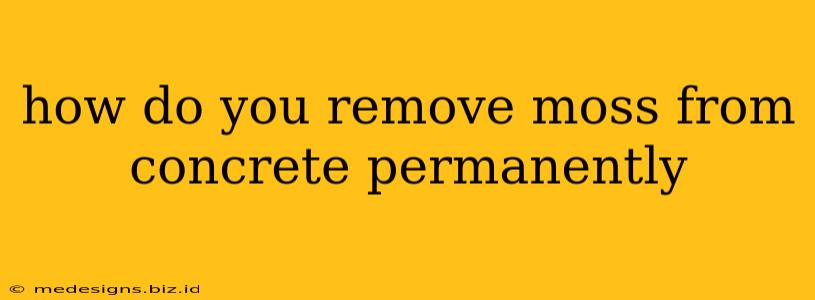Moss on concrete is unsightly, can be slippery, and can even damage the surface over time. But don't worry, getting rid of it permanently doesn't have to be a Herculean task. This comprehensive guide will walk you through effective methods to remove moss from concrete and prevent its return. We'll cover everything from simple home remedies to more powerful professional solutions.
Understanding Moss Growth on Concrete
Before diving into removal methods, it's crucial to understand why moss grows on concrete. Moss thrives in damp, shady areas with poor drainage. Understanding this helps you target the root causes and prevent future infestations. Key factors contributing to moss growth include:
- Excessive Moisture: Poor drainage, leaky gutters, or consistently wet conditions create the ideal breeding ground for moss.
- Shade: Limited sunlight prevents the concrete from drying out, promoting moss growth.
- Porous Concrete: Older or damaged concrete is more susceptible to moss due to increased porosity.
Effective Methods for Moss Removal
Now, let's tackle the removal process. We'll start with gentler options and progress to more powerful solutions if needed. Remember to always prioritize safety: wear protective gear like gloves and eye protection.
1. Manual Removal (For Light Moss Growth):
For small patches of moss, a simple scrubbing can be effective. Use a stiff-bristled brush, a pressure washer (low pressure setting), or a wire brush to gently scrape away the moss. This method works best for newly established moss. Follow up with a thorough rinsing with water.
2. Household Solutions (For Moderate Moss Growth):
Several household items can effectively kill moss:
- White Vinegar: A natural and effective moss killer. Dilute white vinegar with equal parts water, apply to the affected area, and let it sit for 30 minutes before scrubbing. Rinse thoroughly.
- Baking Soda: A mild abrasive that can help remove moss. Make a paste with baking soda and water, apply it to the moss, let it sit for a few hours, then scrub and rinse.
- Bleach Solution (Use with Caution): Bleach is a powerful disinfectant, but use it cautiously and always dilute it with water (a 1:10 ratio of bleach to water is a good starting point). Apply the solution, let it sit for a short period (never longer than 30 minutes), and then thoroughly scrub and rinse. Always wear appropriate protective gear when using bleach.
3. Pressure Washing (For Heavy Moss Growth):
A pressure washer is a powerful tool for removing heavy moss infestations. Use a low-pressure setting to avoid damaging the concrete. Always start with a test area to ensure you're not causing any damage. Afterwards, rinse thoroughly with water.
4. Chemical Moss Killers (For Persistent Problems):
If home remedies and pressure washing aren't enough, consider using a commercially available moss killer specifically designed for concrete. These products are usually more potent and effective but always follow the manufacturer's instructions carefully and prioritize safety.
Preventing Future Moss Growth
Removing moss is only half the battle. Preventing its return requires addressing the underlying causes:
- Improve Drainage: Ensure water flows away from the concrete surface. Repair any leaky gutters or downspouts.
- Increase Sunlight Exposure: Trim overhanging branches or shrubs that cast shade on the concrete.
- Concrete Sealer: Apply a concrete sealer to prevent moisture absorption. This creates a barrier that moss struggles to penetrate. Choose a sealer appropriate for your concrete type.
Regular Cleaning: Regularly cleaning your concrete surfaces with a garden hose or a broom can significantly reduce the chances of moss taking hold.
By following these steps, you can effectively remove moss from concrete permanently and prevent future infestations, keeping your outdoor spaces clean and attractive. Remember to always prioritize safety and choose the most appropriate method for your specific situation and level of moss growth.
